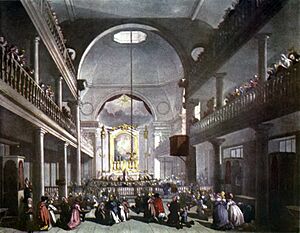Sardinian Embassy Chapel facts for kids
The Sardinian Embassy Chapel was an important Catholic church in London. It was connected to the Embassy of the Kingdom of Sardinia. This chapel was located in the Lincoln's Inn area. It was taken down in 1909 to make way for new developments.
Contents
History of the Chapel
Early Days of the Chapel
The chapel existed for several years before it became linked to the Sardinian Embassy. During the time of King James II, in the late 1600s, a building at 54 Lincoln's Inn Fields was used by Franciscan priests. They built a chapel behind it. After King James II left the country in 1688, the Franciscans also left. A crowd then destroyed the chapel.
By 1700, the buildings were repaired and used by the Portuguese embassy. Later, around 1715, it became a Sicilian embassy chapel. In 1720, the Duke of Savoy traded his Kingdom of Sicily for the Kingdom of Sardinia. The first mention of it as the Sardinian chapel was in 1722.
Fires and Rebuilding
In 1759, the chapel completely burned down. However, within three years, a beautiful and large new building was constructed. The King of Sardinia paid for this new chapel. It was filled with valuable silver items and artworks. The silver still belongs to the church that replaced it. Today, you can see this silver on display at the Victoria and Albert Museum.
A famous picture from the 1700s shows London's Catholic bishop, Richard Challoner, preaching in the Sardinian Chapel. Behind him, you can see the chancel with a painting of the Deposition. Bishop Challoner called the Embassy Chapel "the chief support of religion in London." He said it acted like a main church for Catholics in the city.
Why Embassy Chapels Were Special
Embassy chapels were a unique type of church. In earlier times, after the Reformation, some countries banned certain religions. Embassy staff, who usually lived at the embassy, were allowed to have their own chapels and priests. This was especially true if they lived in a country that did not allow their religion. Soon, people who shared the same faith would come to these embassy chapels for services.
In London, the streets outside the Spanish, French, and Venetian embassies often saw public protests. Sometimes these protests were violent. Police would sometimes try to arrest British people who attended Catholic services at these chapels. However, embassy chapels were not just for Catholic embassies or only in Britain. The Dutch Republic, for example, had chapels in twelve of its embassies. These chapels served as churches for local Reformed Protestants.
By the late 1700s, a new legal idea called extraterritoriality became common. This meant that "the ambassador and the embassy area were considered to be on the soil of his homeland." This meant they were only subject to their home country's laws. Because of this, by the 1700s, English people were no longer bothered for attending services at the Sardinian Embassy. For example, on Easter Sunday in 1772, James Boswell and Pasquale Paoli "worshipped together at the Sardinian Chapel."
Challenges and Changes
The chapel was badly damaged again during the Gordon riots in 1780. After this, the government paid for the damages, and the chapel was repaired. It reopened in 1781. In 1798, the Sardinian ambassador closed the chapel and planned to rent out the building. However, the priests and Bishop John Douglass were able to get the property. The embassy building then became a house for clergy, and the chapel reopened in 1799. It continued to be supported and protected by the King of Sardinia until 1858.
In 1853, the chapel's name was changed to St Anselm's Church. Then, in 1861, its name was changed again to the Church of St Anselm and St Cecilia.
Moving On: Demolition and a New Church
When the wide road of Kingsway was built through the many small streets west of Lincoln's Inn Fields, the church was one of the many buildings that had to be taken down. A new place to build, facing Kingsway, was provided.
By selling the old site in 1902, Cardinal Vaughan was able to buy the new site in Kingsway. He then built the current Church of St Anselm and St Cecilia there. He even had about £10,000 left over, which he put towards the Westminster Cathedral Building Fund.
Several items from the old chapel were moved to the new church. These include the oval marble font with its wooden cover, the organ from 1857, the coat of arms of the House of Savoy, and the large painting of the Deposition. Also, in the south aisle, the sarcophagus-shaped Lady Altar was moved. The old Sardinian Chapel was demolished in 1909. It was replaced by the Church of St Anselm and St Cecilia.
See also
- Embassy chapel
- St Etheldreda's Church, London
- Church of Our Lady of the Assumption and St Gregory
- St James's, Spanish Place
Web Links & Sister Projects
- Church of St Anselm and St Cecilia, About the Parish


